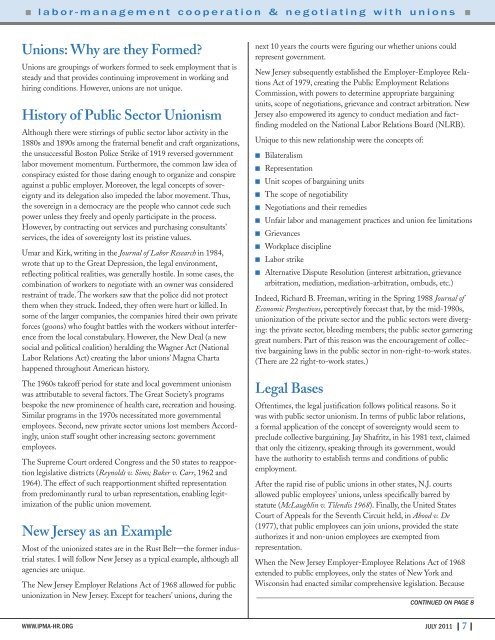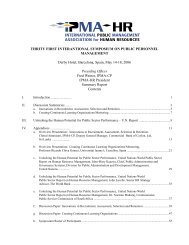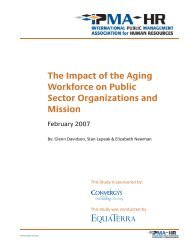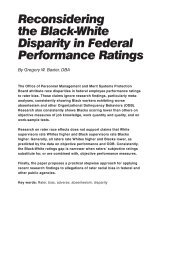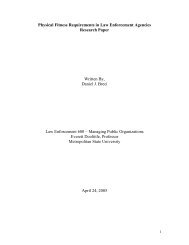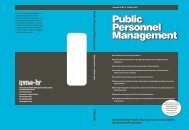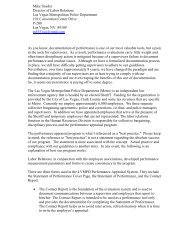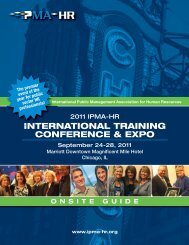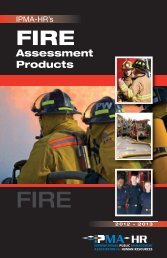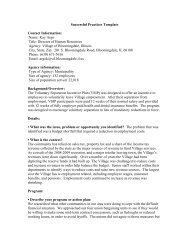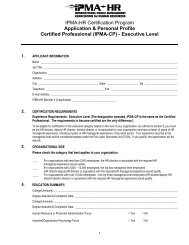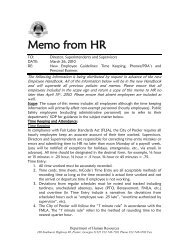July 2011 issue of HR News magazine - IPMA
July 2011 issue of HR News magazine - IPMA
July 2011 issue of HR News magazine - IPMA
Create successful ePaper yourself
Turn your PDF publications into a flip-book with our unique Google optimized e-Paper software.
■ l a b o r - m a n a g e m e n t c o o p e r a t i o n & n e g o t i a t i n g w i t h u n i o n s ■<br />
Unions: Why are they Formed?<br />
Unions are groupings <strong>of</strong> workers formed to seek employment that is<br />
steady and that provides continuing improvement in working and<br />
hiring conditions. However, unions are not unique.<br />
History <strong>of</strong> Public Sector Unionism<br />
Although there were stirrings <strong>of</strong> public sector labor activity in the<br />
1880s and 1890s among the fraternal benefit and craft organizations,<br />
the unsuccessful Boston Police Strike <strong>of</strong> 1919 reversed government<br />
labor movement momentum. Furthermore, the common law idea <strong>of</strong><br />
conspiracy existed for those daring enough to organize and conspire<br />
against a public employer. Moreover, the legal concepts <strong>of</strong> sovereignty<br />
and its delegation also impeded the labor movement. Thus,<br />
the sovereign in a democracy are the people who cannot cede such<br />
power unless they freely and openly participate in the process.<br />
However, by contracting out services and purchasing consultants’<br />
services, the idea <strong>of</strong> sovereignty lost its pristine values.<br />
Umar and Kirk, writing in the Journal <strong>of</strong> Labor Research in 1984,<br />
wrote that up to the Great Depression, the legal environment,<br />
reflecting political realities, was generally hostile. In some cases, the<br />
combination <strong>of</strong> workers to negotiate with an owner was considered<br />
restraint <strong>of</strong> trade. The workers saw that the police did not protect<br />
them when they struck. Indeed, they <strong>of</strong>ten were hurt or killed. In<br />
some <strong>of</strong> the larger companies, the companies hired their own private<br />
forces (goons) who fought battles with the workers without interference<br />
from the local constabulary. However, the New Deal (a new<br />
social and political coalition) heralding the Wagner Act (National<br />
Labor Relations Act) creating the labor unions’ Magna Charta<br />
happened throughout American history.<br />
The 1960s take<strong>of</strong>f period for state and local government unionism<br />
was attributable to several factors. The Great Society’s programs<br />
bespoke the new prominence <strong>of</strong> health care, recreation and housing.<br />
Similar programs in the 1970s necessitated more governmental<br />
employees. Second, new private sector unions lost members Accordingly,<br />
union staff sought other increasing sectors: government<br />
employees.<br />
The Supreme Court ordered Congress and the 50 states to reapportion<br />
legislative districts (Reynolds v. Sims; Baker v. Carr, 1962 and<br />
1964). The effect <strong>of</strong> such reapportionment shifted representation<br />
from predominantly rural to urban representation, enabling legitimization<br />
<strong>of</strong> the public union movement.<br />
New Jersey as an Example<br />
Most <strong>of</strong> the unionized states are in the Rust Belt—the former industrial<br />
states. I will follow New Jersey as a typical example, although all<br />
agencies are unique.<br />
The New Jersey Employer Relations Act <strong>of</strong> 1968 allowed for public<br />
unionization in New Jersey. Except for teachers’ unions, during the<br />
next 10 years the courts were figuring our whether unions could<br />
represent government.<br />
New Jersey subsequently established the Employer-Employee Relations<br />
Act <strong>of</strong> 1979, creating the Public Employment Relations<br />
Commission, with powers to determine appropriate bargaining<br />
units, scope <strong>of</strong> negotiations, grievance and contract arbitration. New<br />
Jersey also empowered its agency to conduct mediation and factfinding<br />
modeled on the National Labor Relations Board (NLRB).<br />
Unique to this new relationship were the concepts <strong>of</strong>:<br />
■ Bilateralism<br />
■ Representation<br />
■ Unit scopes <strong>of</strong> bargaining units<br />
■ The scope <strong>of</strong> negotiability<br />
■ Negotiations and their remedies<br />
■ Unfair labor and management practices and union fee limitations<br />
■ Grievances<br />
■ Workplace discipline<br />
■ Labor strike<br />
■ Alternative Dispute Resolution (interest arbitration, grievance<br />
arbitration, mediation, mediation-arbitration, ombuds, etc.)<br />
Indeed, Richard B. Freeman, writing in the Spring 1988 Journal <strong>of</strong><br />
Economic Perspectives, perceptively forecast that, by the mid-1980s,<br />
unionization <strong>of</strong> the private sector and the public sectors were diverging:<br />
the private sector, bleeding members; the public sector garnering<br />
great numbers. Part <strong>of</strong> this reason was the encouragement <strong>of</strong> collective<br />
bargaining laws in the public sector in non-right-to-work states.<br />
(There are 22 right-to-work states.)<br />
Legal Bases<br />
Oftentimes, the legal justification follows political reasons. So it<br />
was with public sector unionism. In terms <strong>of</strong> public labor relations,<br />
a formal application <strong>of</strong> the concept <strong>of</strong> sovereignty would seem to<br />
preclude collective bargaining. Jay Shafritz, in his 1981 text, claimed<br />
that only the citizenry, speaking through its government, would<br />
have the authority to establish terms and conditions <strong>of</strong> public<br />
employment.<br />
After the rapid rise <strong>of</strong> public unions in other states, N.J. courts<br />
allowed public employees’ unions, unless specifically barred by<br />
statute (McLaughlin v. Tilendis 1968). Finally, the United States<br />
Court <strong>of</strong> Appeals for the Seventh Circuit held, in Abood v. De<br />
(1977), that public employees can join unions, provided the state<br />
authorizes it and non-union employees are exempted from<br />
representation.<br />
When the New Jersey Employer-Employee Relations Act <strong>of</strong> 1968<br />
extended to public employees, only the states <strong>of</strong> New York and<br />
Wisconsin had enacted similar comprehensive legislation. Because<br />
CONTINUED ON PAGE 8<br />
WWW.<strong>IPMA</strong>-<strong>HR</strong>.ORG JULY <strong>2011</strong> | 7 |


